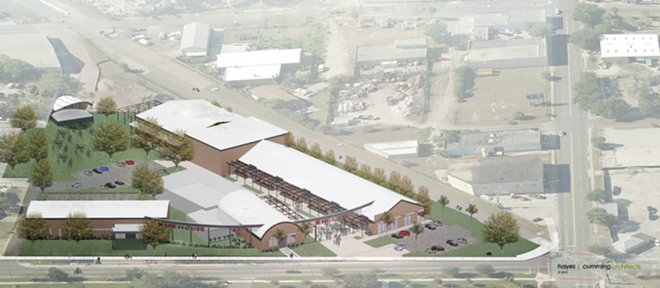If the adage “Where there’s a will, there’s a way” were only literal truth, St. Petersburg’s Warehouse Arts District Association would be well on its way to raising $350,000 before Nov. 1 to create a 50,000-square-foot complex of below-market rate artists’ studios by renovating the five warehouses of the Ace Recycling compound at 515 22nd St S.
Last Thursday, during a fundraising kick-off event called “Envision the Enclave,” the will to succeed made a strong showing.
Duncan McClellan, the glass artist whose studio and hot shop thrives a few blocks away, donated a brochure outlining the Association’s plans, and offered up benefits for prospective donors including (at the upper echelon) hosting a glass blowing demo and party at his space. Jeff Schorr, who owns Craftsman House on Central Avenue, passed out fliers advertising his gallery’s annual “Pot Roast” pottery charity auction and dinner on Sept. 22; this year, it will benefit the Warehouse Arts Enclave project. And Bob Devin Jones, artistic director of the Studio@620 in downtown St. Pete, led a scripted tour of the existing warehouses that included folksy pantomimed demos of art-making techniques like welding, woodworking and painting, and occasionally rhymed.
“Imagine… something really good for the senses without any fences,” Jones urged a dozen media representatives in attendance. By the end of the evening, 300-400 people had attended the event, which brought in $12,000 for the Enclave fund, according to WADA president Mark Aeling.
The association is an old hand at surpassing expectations. In two years of existence, the group has attracted more than 60 member artists and businesses, and last year its monthly free monthly trolley during Second Saturday art walks served 3,700 riders.
Creating the Enclave, however, would be a project of a different order of magnitude. If the group reaches its November goal, it will be able to make a $200,000 down payment on the purchase of the Ace compound for $975,000; the remainder would be paid through a five-year mortgage. Leftover cash would be spent on necessary environmental inspections, an architect’s design for a multi-phase, multi-year build out, and transformation of 20,000-square feet of the compound into rentable studios, which could begin to draw income for further renovations. In other words, securing $350,000 in donations would be a first step — albeit an important one. Afterwards, the association, which is a nonprofit organization, would pursue grants from institutional and government funders, Schorr said.
The compound already houses a pair of artists’ spaces: MGA Sculpture Studio, run by Aeling, and Soft Water Studios, home to painter Carrie Jadus and a handful of other artists. If the Enclave were realized, it would house dozens more, along with an exhibition space, classrooms for teaching, a foundry for metal casting, recording studios, offices and a micro-brew pub, according to promotional materials.
WADA’s pitch to charitable donors is that the whole package benefits the general public as much as artists by providing a place to observe art being made, to learn and to socialize. (Hence, the sentiment of “no fences” and renderings of a preliminary Enclave design that show visitors entering through an iconic archway on 22nd St S.) And sited directly along the Pinellas Trail just southwest of the Morean Center for Clay’s converted train station, such an arts destination could also help promote the use and safety of the walk-ride path, so the argument goes.
“It’s an arts project, but it’s also an economic development project,” Shorr explained.
If WADA’s plan — or at least the urgency of it — seems improbable, you wouldn’t know it from the heartfelt devotion of members like attorney Joseph Kapusta Jr., who authored the contract for the purchase between the association and the current owner of the compound. When asked how the group would raise so much money in what amounts to two months, Kapusta flashed a strained smile and replied, “It just has to happen.”
Judging from last week’s Enclave kick-off, he may be a dreamer (in the best sense of the word), but he’s not the only one.


